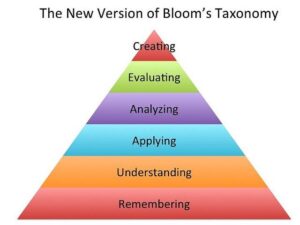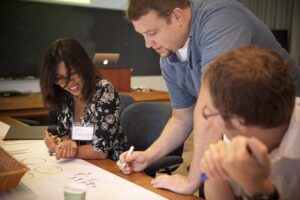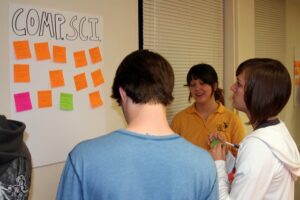
Image of Studentsin Class by roanokecollege is licensed under CC BY 4.0
“We cannot change anything if we cannot change our thinking.”
~ Santosh Kalwar
Where Are You Now?
Assess your present knowledge and attitudes.
| Yes | Unsure | No | |
|---|---|---|---|
| 1. I am a good problem solver. | |||
| 2. I am considered creative by my friends. | |||
| 3. I have good judgment. | |||
| 4. I find it easy to make decisions quickly. | |||
| 5. My decisions usually turn out to be good decisions. | |||
| 6. I like to think things through before speaking. | |||
| 7. I am not shy about asking questions when I don’t understand something. | |||
| 8. I enjoy good discussions and arguments. | |||
| 9. I regularly practice an art form (music, acting, painting, etc.) | |||
| 10. I enjoy hearing other people’s points of view, even when I disagree with them. | |||
| 11. I usually question information presented as fact on the Internet or television. |
Where Do You Want to Go?
Think about how you answered the questions above. Be honest with yourself. On a scale of 1 to 10, how would you rate your level of thinking skills at this time?
| Poor thinking skills | Excellent thinking skills | |||||||||||||||||
|---|---|---|---|---|---|---|---|---|---|---|---|---|---|---|---|---|---|---|
| 1 | 2 | 3 | 4 | 5 | 6 | 7 | 8 | 9 | 10 | |||||||||
In the following list, circle the three most important areas in which you think you can improve:
- Applying information
- Analyzing information
- Thinking critically
- Asking questions about information
- Evaluating information
- Coming up with new ideas
- Solving problems
- Making decisions
- Identifying weaknesses in ideas
- Choosing sources for research
Are there other areas in which you can improve your thinking skills? Write down other things you feel you need to work on.
What Is Thought?
- Thinking is the mental process you use to form associations and models of the world. When you think, you manipulate information to form concepts, to engage in problem-solving, to reason, and to make decisions.
- Thought can be described as the act of thinking that produces thoughts, which arise as ideas, images, sounds, or even emotions.
The Cognitive Domain of Learning
The cognitive domain of learning is divided into six main learning-skill levels, or learning-skill stages, which are arranged hierarchically—moving from the simplest of functions like remembering and understanding, to more complex learning skills, like applying and analyzing, to the most complex skills—evaluating and creating. The lower levels are more straightforward and fundamental, and the higher levels are more sophisticated.[1] See Figure 1, below.
 Image of The New Version of Bloom’s Taxonomy by Andrea Hernandez is licensed under CC BY-SA 4.0
Image of The New Version of Bloom’s Taxonomy by Andrea Hernandez is licensed under CC BY-SA 4.0
The following table describes the six main skill sets within the cognitive domain.
| MAIN SKILL LEVELS | DESCRIPTION | EXAMPLES OF RELATED LEARNING SKILLS (specific actions related to the skill set) |
| Remembering | Recognize or recall knowledge already gained, and use it to produce, retrieve or recite definitions, facts, and lists. | identify · relate · list · define · recall · memorize · repeat · record · name |
| Understanding | The ability to grasp or construct meaning from oral, written, and graphic messages.
|
restate · locate · report · recognize · explain · express · identify · discuss · describe · review · infer · illustrate · interpret · draw · represent · differentiate · conclude |
| Applying | Use learned material (or implement the material) in new and concrete situations | apply · relate · develop · translate · use · operate · organize · employ · restructure · interpret · demonstrate · illustrate · practice · calculate · show · exhibit · dramatize |
| Analyzing | The ability to break down or distinguish the parts of material into its components, so that its organizational structure may be better understood. | analyze · compare · inquire · examine · contrast · categorize · differentiate · contrast · investigate · detect · survey · classify · deduce · scrutinize · discover · inspect · dissect · discriminate · separate |
| Evaluating | Ability to judge, check, and even critique the value of material for a given purpose. | judge · assess · compare · evaluate · conclude · measure · deduce · argue · decide · choose · rate · select · estimate · validate · consider · appraise · value · criticize · infer |
| Creating | Put parts together to form a coherent or unique new whole. Reorganize elements into a new pattern or structure through generating, planning, or producing. | compose · produce · design · assemble · create · prepare · predict · modify · plan · invent · formulate · collect · generalize · document combine · relate · propose · develop · arrange · construct · organize · originate · derive · write · propose |
You can explore these concepts further in the two videos, below.
The first is from the Center for Learning Success at Louisiana State University. It discusses Bloom’s with regard to student success in college.
Video: Bloom’s Taxonomy learning levels
This next video is a culturally based way of understanding and applying Bloom’s taxonomy.
Video: Bloom’s Taxonomy Featuring Harry Potter Movies
You can download a transcript of the video here.
Critical Thinking Skills

Image of Three Students by PopTech is licensed under CC BY-SA 4.0
What Is Critical Thinking?
Critical thinking is clear, reasonable, reflective thinking focused on deciding what to believe or do. It means asking probing questions like, “How do we know?” or “Is this true in every case or just in this instance?” It involves being skeptical and challenging assumptions, rather than simply memorizing facts or blindly accepting what you hear or read.
Critical Thinking IS
- Skepticism
- Examining assumptions
- Challenging reasoning
- Uncovering biases
Critical Thinking is NOT
- Memorizing
- Group thinking
- Blind acceptance of authority
The following video, from Lawrence Bland, presents the major concepts and benefits of critical thinking.
What Is Logic, and Why Is It Important in Critical Thinking?
The word logic comes from the Ancient Greek logike, referring to the science or art of reasoning. Using logic, a person evaluates arguments and reasoning and strives to distinguish between good and bad reasoning, or between truth and falsehood. Using logic, you can evaluate ideas or claims people make, make good decisions, and form sound beliefs about the world.[1]
Questions of Logic in Critical Thinking
- What’s happening? Gather the basic information and begin to think of questions.
- Why is it important? Ask yourself why it’s significant and whether or not you agree.
- What don’t I see? Is there anything important missing?
- How do I know? Ask yourself where the information came from and how it was constructed.
- Who is saying it? What’s the position of the speaker and what is influencing them?
- What else? What if? What other ideas exist and are there other possibilities?
Problem-Solving with Critical Thinking
STRATEGIES and ACTION CHECKLIST
- Define the problem
- o Identify the problem
- o Provide as many supporting details as possible
- o Provide examples
- o Organize the information logically
- Identify available solutions
- o Use logic to identify your most important goals
- o Identify implications and consequences
- o Identify facts
- Compare and contrast possible solutions
- o Select your solution
- o Use gathered facts and relevant evidence
- o Support and defend solutions considered valid
- o Defend your solution
Developing Yourself As a Critical Thinker

Image of Students Putting Post-its on Wall by Hector Alejandro is licensed under
Critical thinking is a fundamental skill for college students, but it should also be a lifelong pursuit. Below are additional strategies to develop yourself as a critical thinker in college and in everyday life:
- Reflect and practice: Always reflect on what you’ve learned. Is it true all the time? How did you arrive at your conclusions?
- Use wasted time: It’s certainly important to make time for relaxing, but if you find you are indulging in too much of a good thing, think about using your time more constructively. Think about the time of day you are most effective and have the most energy. Plan to do your most difficult work during these times.
- Redefine the way you see things: It can be very uninteresting to always think the same way. Challenge yourself to see familiar things in new ways. Put yourself in someone else’s shoes and consider things from a different angle or perspective. If you’re trying to solve a problem, list all your concerns: what you need in order to solve it, who can help, what some possible barriers might be, etc. It’s often possible to reframe a problem as an opportunity. Try to find a solution where there seems to be none.
- Analyze the influences on your thinking and in your life: Why do you think or feel the way you do? Analyze your influences. Think about who in your life influences you. Do you feel or react a certain way because of social convention, or because you believe it is what is expected of you? Try to break out of any molds that may be constricting you.
- Express yourself: Critical thinking also involves being able to express yourself clearly. Most important in expressing yourself clearly is stating one point at a time. You might be inclined to argue every thought, but you might have greater impact if you focus just on your main arguments. This will help others to follow your thinking clearly. For more abstract ideas, assume that your audience may not understand. Provide examples, analogies, or metaphors where you can.
- Enhance your wellness: It’s easier to think critically when you take care of your mental and physical health. Try taking 10-minute activity breaks to reach 30 to 60 minutes of physical activity each day. Try taking a break between classes and walk to the coffee shop that’s farthest away. Scheduling physical activity into your day can help lower stress and increase mental alertness.
Activity: Reflect on Critical Thinking
Objective
- Apply critical thinking strategies to your life
Directions:
- Think about someone you consider to be a critical thinker (friend, professor, historical figure, etc). What qualities does he/she have?
- Review some of the critical thinking strategies discussed on this page. Pick one strategy that makes sense to you. How can you apply this critical thinking technique to your academic work?
- Habits of mind are attitudes and beliefs that influence how you approach the world (i.e., inquiring attitude, open mind, respect for truth, etc). What is one habit of mind you would like to actively develop over the next year? How will you develop a daily practice to cultivate this habit?
- Write your responses in journal form, and submit according to your instructor’s guidelines.
Outside Resources
- Glossary of Critical Thinking Terms
- Critical Thinking Self-Assessment
- Logical Fallacies Jeopardy Template
- Thinking Critically | Learning Commons
- Foundation for Critical Thinking
- Critical Thinking in Everyday Life
- Skeptoid
- Infact TedTalk #1
- Infact TedTalk #2
- Infact TedTalk #3
- Here Be Dragons
In Real Life
Charles

Photo by Daniel Frese is licensed in the Public Domain
After months of searching for a part-time job, Charles accepted a position as a community organizer with a local non-profit. His primary responsibilities were to register new voters and inform registered voters about ballot issues. Although personally, he was not deeply passionate about voting, politics, or even interested in community issues, he was excited about the flexibility of his new job. Charles only had four classes to take in order to earn his associate’s degree in Business Administration. He needed a flexible schedule in order to complete his courses and work. His supervisor agreed to schedule Charles around his classes as long as Charles met the required weekly goals.
Charles’ first impression of community organizing was that it was going to be really easy. He thought that people would immediately register to vote after he asked them. Charles did not think it was necessary to engage prospective voters in conversation about voting. He simply asked if they wanted to register to vote and if the answer was no, he moved on to the next prospect. Charles did not think it was helpful to practice approaching prospective voters or to learn more about the issues and candidates that were on the upcoming ballot.
After two weeks into the position, Charles’ supervisor expressed dissatisfaction with his performance which made Charles fearful of losing his job. He felt that this job provided the most flexibility for him to continue to attend his classes. However, if Charles did not improve his ability to register more voters, he would lose his job.
Discussion Questions:
- How does Charles’ personal interest in voting and community issues impact his performance?
- How could Charles use critical thinking skills to improve his ability to register more voters?
- What skills do you think Charles might have as a business student that could be useful to him in his new job?
- How could Charles’ supervisor support and guide him in dealing with prospective voters?
Chapter Discussion Questions
- What is the difference between thinking and thought? Give an example of when and how you use each.
- What is critical thinking? Has there ever been a time when you, or someone you have known, has preferred ignorance over being informed? Why?
- What are typical characteristics and attributes of critical thinkers? List them. Are you a critical thinker? Give an example/story where you have used critical thinking skills.
![]() End of Chapter Credits Critical Thinking by Tammy Root and Tonjala Eaton is adapted from Lumen Learning and is licensed under the Creative Commons Attribution 4.0 International License.
End of Chapter Credits Critical Thinking by Tammy Root and Tonjala Eaton is adapted from Lumen Learning and is licensed under the Creative Commons Attribution 4.0 International License.
